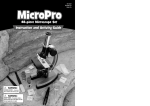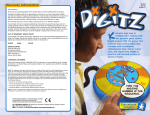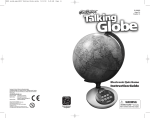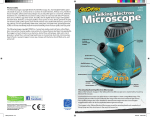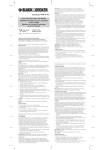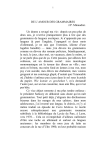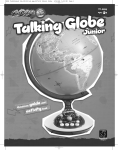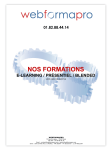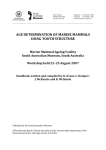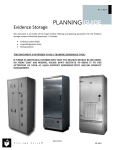Download Educational Insights Talking Telescope GeoSafari User's Manual
Transcript
EI-8805 Ages 5+ Grades K+ Explore the world of animals and outer space! Table of Contents Introducing GeoSafari Talking Telescope . . . . . . . . . . . . 3 GeoSafari Talking Telescope Features . . . . . . . . . . . . . . 4 Getting Ready to Play . . . . . . . . . . . . . . . . . . . . . . . . . . . . . 5 Let’s Play a Facts Game . . . . . . . . . . . . . . . . . . . . . . . . . . . 6 Let’s Play a Quiz Game . . . . . . . . . . . . . . . . . . . . . . . . . . . . 6 Helpful Hints . . . . . . . . . . . . . . . . . . . . . . . . . . . . . . . . . . . . . . 7 Exploring with the Detachable Telescope . . . . . . . . . . . 7 Caring for Your GeoSafari Talking Telescope . . . . . . . . 7 Troubleshooting . . . . . . . . . . . . . . . . . . . . . . . . . . . . . . . . . 7 How to Clean Your GeoSafari Talking Telescope . . . . 7 More Fun Facts About Animals . . . . . . . . . . . . . . . . . . . . . 8 More Fun Facts About Space . . . . . . . . . . . . . . . . . . . . . .10 Battery Installation and Information . . . . . . . . . . . . . . . 12 Introducing GeoSafari Talking Telescope Did you know that a newborn koala is about the size of a jellybean? Or that there are over 1,000 rings around the planet Saturn? With the GeoSafari Talking Telescope you can explore the world of animals and outer space. Get an up-close VIEW of 12 wild animals and 8 outer space phenomena as you HEAR cool facts or TEST your knowledge in fun quiz games. You’ll see everything from amazing animals like pandas and penguins to out-of-this-world planets, stars, and spacecraft. Plus, you can use the detachable telescope to view your own incredible world! Talking Telescope With the interactive GeoSafari Talking Telescope, you can view 20 colorful images of animals and outer space through the special viewfinder as you listen to 200 fascinating facts and challenging questions about the slides! It’s easy to use. Just insert a slide, press the Facts or the Quiz button, and get ready to learn while you play. Realistic animal sounds and fun space sound effects add to the learning fun! Detachable Telescope The GeoSafari Talking Telescope features an 8-inch detachable telescope for on-the-go exploring. This 4x magnification telescope is attached to the Talking Telescope with a strong magnet, but also pivots up and down on the unit for easy viewing. Slides © 2003 Educational Insights, Inc. Rancho Dominguez, CA 90220 (USA) All rights reserved. Made in China. Conforms to: ASTM F 963, FCC Part 15 Please retain this information. We welcome your comments or questions about our products or service. Call: (800) 995-4436 toll-free Monday-Friday 8:30 a.m. to 5:00 p.m. CST E-mail: [email protected] Visit our website: www.educationalinsights.com 2 Inside the handy storage compartment are 20 full-color slide images to use with your Talking Telescope. The slides feature photographs of awesome animals and spectacular space images from NASA. Each slide is labeled for easy identification. Guide This guide includes everything you need to know about using your GeoSafari Talking Telescope. PLUS, there’s a special section with more fun facts about each slide and suggestions for exploring your world. 3 Getting Ready to Play GeoSafari Talking Telescope Features Before using your GeoSafari Talking Telescope for the first time, install 4 AA batteries. See the diagram and directions on page 12. View images through the soft comfort VIEWFINDER. Turn the 4x FOCUSING MAGNIFIER for clear slide images. Detachable TELESCOPE (4x magnification) for on-the-go exploring! 1. Press the On/Off button to begin. The Talking Telescope will ask you to choose the Facts or Quiz game. 2. Choose the game you’d like to play—FACTS or QUIZ. Press the Facts button to learn about animals and outer space. 20 interactive SLIDES feature amazing animals and spectacular space phenomena Press the Quiz button to play a quiz game about animals and outer space. 3. Open the slide compartment and choose a slide. 4. Insert the slide into the viewing area. STORAGE COMPARTMENT stores and protects slides. Turn the DIAL to hear 5 facts and 5 questions for each slide. Battery-saving AUTOMATIC SHUT-OFF turns unit off after two minutes of non-use. Press the ON/OFF Button to turn the unit on and off. Press the FACTS Button to learn about animals and outer space. CONTROL PANEL Press the VOLUME Button to choose volume level—low, medium, or high. 4 Press the QUIZ Button to see how much you’ve learned. Press the LETTER Buttons to enter slide codes and answer questions. 5. Close one eye and look into the viewfinder. For better viewing, place the Talking Telescope on a low surface so that you can look down into the viewfinder easily. Focus the slide image by turning the focusing magnifier until the picture looks sharp and clear. 6. Enter the 3-letter code printed on the slide. Use the A B C buttons to enter the code. 5 Let’s Play a Facts Game If you have pressed the Facts button, you will learn five fascinating facts about the image on your slide. 1. The Talking Telescope identifies the slide and plays a fun sound. For example, “You chose the wolf” is followed by a wolf howling. 2. Close one eye and look into the viewfinder. You’ll hear a fun fact about the wolf. Helpful Hints 4. After you have listened to all five facts, you can play a Quiz game (see below) or choose another slide. (Note: You can switch from the Facts game to the Quiz game at any time.) • Be careful to hold your slides on the side. Smudges will make the images harder to see. • To clean slides, just wipe lightly with a damp cloth, dry, and put back in the storage drawer. • When arranging slides in the storage drawer, be sure they are properly aligned. • Use the focusing magnifier to adjust the Talking Telescope for individual use. • Forget to turn it off? The Talking Telescope will automatically shut off after two minutes of non-use. Let’s Play a Quiz Game Exploring with the Detachable Telescope If you have chosen the Quiz game, you will play a five-question game about the image on your slide. With the detachable telescope you can explore a variety of places—from your backyard to the ballpark! Here are some places to check out with the telescope: 3. Turn the dial to hear another fun fact. As you look and listen, you’ll learn lots of interesting information. There are five facts for each slide. Wolves have 42 teeth, including four sharp fangs called canines. 1. The Talking Telescope identifies the slide and plays a fun sound. For example, “You chose the lion” is followed by a lion roaring. 2. Close one eye and look into the viewfinder. You’ll hear a question about the lion. • Some questions are True or False questions. To answer, press A for True or press B for False. True or false? Both lions and tigers have manes. 3. Turn the dial to hear another question. Continue to look at the slide as you play the Quiz game. There are five questions in each Quiz game. 4. After you have finished the Quiz game, you can press the Facts button or choose another slide. (Note: You can switch from the Quiz game to the Facts game at any time.) • Observe and record information about animals in your neighborhood, including pets, birds, and other creatures. • View the night sky, including the Moon, stars, and constellations. • Focus on sporting events. • Check out the view from different windows in the house or from the car. Caring for Your GeoSafari Talking Telescope • Some questions are Multiple Choice questions. To answer, press the A, B, or C button. (You have 2 chances to answer multiple choice questions correctly.) 6 TIP: All of the questions in the Quiz game are based on information you learned while listening to the Facts game. If you answer a question incorrectly, you can press the Facts button to review the fact. Troubleshooting Saturn’s rings are made of pieces of ice, rock, and A) gas B) dust C) stars If your GeoSafari Talking Telescope is not working properly, turn the unit off and then on again. If this does not correct the problem, remove and reinstall the batteries, making certain that they snap into place, making contact with the supply terminals. Finally, if the unit still is not operating correctly, replace the batteries with a fresh set. Weak batteries can cause a variety of malfunctions. To prolong battery life, the Talking Telescope will automatically shut itself off after two minutes of non-use. How to Clean Your GeoSafari Talking Telescope Clean your GeoSafari Talking Telescope with a slightly damp or dry cloth. Do not immerse the Talking Telescope in water. Do not spray liquid of any kind on the Talking Telescope. 7 More Fun Facts About Animals Wolf Orangutan • Wolves vomit partly digested meat to feed their pups. • Wolves use their tails and the position of their ears to communicate. • A wolf’s jaws are twice as strong as a dog’s jaws. • Adult orangutans spend most of their time alone. • Most male orangutans grow big cheek pads and throat pouches. • The orangutan is the only great ape that comes from Asia. Lion • Lion cubs are born with spots. • Lions “stretch out” their whiskers to feel their way in the dark. • Tiny hooks on a lion’s tongue help it scrape meat off its prey’s bones. Walrus Komodo Dragon* Red-eyed Tree Frog • Komodo dragons are excellent swimmers. • Adult Komodo dragons eat younger members of their own species. • Komodo dragons eat carrion (dead animal flesh), even if it’s crawling with worms! • Red-eyed tree frogs are nicknamed “monkey frogs” because they are great climbers. • Red-eyed tree frogs have a third eyelid. • Male red-eyed tree frogs wrestle one another to mate with the females. • Male walruses “sing” underwater to attract mates. • Both male and female walruses have tusks. • Walruses live in large herds. *Photograph © Adrian Warren / www.lastrefuge.co.uk Elephant Polar Bear • An elephant grows six sets of teeth during its lifetime. • Elephants live in family groups led by the oldest female. • The only hair on an adult elephant’s body is at the tip of its tail. • Polar bears hiss like cats when they are angry. • Female polar bears usually give birth to twin cubs. • A polar bear’s 12-inch paws act like giant “snowshoes,” spreading the bear’s weight over thin ice. Koala • Koalas eat so many eucalyptus leaves, they smell like a cough drop. • Koalas are mostly nocturnal. This means they are active at night. • The koala’s scientific name means “pouch bear.” Tarantula • Female tarantulas lay their eggs in a cocoon. • Tarantulas live in burrows, trees, and on the ground. • Female tarantulas may seriously injure males during mating. Penguin Panda • Unlike some bears, pandas do not hibernate. • Pandas spend more than half their day eating. • Female pandas usually give birth to only one cub. 8 • When swimming long distances, penguins leap out of the water to breathe like dolphins do. • Penguins can stay underwater for more than 10 minutes at a time. • A penguin’s tongue is armed with backward facing spikes that keep slippery seafood from escaping. 9 More Fun Facts About Space Earth International Space Station • Earth spins like a top. This movement is called rotating. • The thin shell of air around Earth is called its atmosphere. • Earth is mostly made up of rock and metal. • When finished, the Space Station will be the largest spacecraft ever built. • The Space Station orbits about 230 miles above Earth. • Astronauts aboard the Space Station play video games, listen to CDs, and get e-mail from their families. Moon Comet • Land formations, like mountains and plains, create the “man in the moon’s” face. • An American astronaut was the first human to set foot on the Moon. • The Moon is larger than the planet Pluto. • The word “comet” comes from a word that means “long haired.” • A comet’s glow is light reflected from the Sun. • Some scientists think that comets are the oldest bodies in the solar system. Saturn • Long ago people thought Saturn’s rings were “ears”! • Each of Saturn’s seasons lasts about 71/ 2 years. • It takes Saturn nearly 30 years to travel around the Sun. Jupiter • It takes Jupiter nearly 12 years to orbit the Sun. • Jupiter has the biggest moon in the solar system. • Io, one of Jupiter’s moons, has active volcanoes on it. Galaxy • Stars shine because they are hot. • Stars look tiny because they are so far away. • There are 200 billion stars in our Milky Way Galaxy. Space Shuttle • Astronauts on the Space Shuttle exercise every day. • There is no shower or bathtub on the Space Shuttle, so astronauts take sponge baths. • The Space Shuttle is made up of three parts: the Orbiter, Solid Rocket Boosters, and External Tank. *Space images are courtesy of NASA. 10 11 Battery Installation and Information For best operation, always use fresh alkaline batteries. Other battery types will have a shorter life. 1. Carefully open the battery compartment door located on the bottom of the unit by loosening the screws holding it in place. 2. Install four fresh AA batteries (not included) in the battery compartment, following the diagram showing correct battery installation inside the compartment. • Batteries must be inserted with the correct polarity. • Do not mix old and new batteries. • Non-rechargeable batteries must not be recharged. • Do not use rechargeable batteries. • Do not mix different types of batteries: alkaline, standard (carbon-zinc), or rechargeable (nickel-cadmium) batteries. • Only batteries of the same type are to be used. • Remove exhausted batteries from unit. • The supply terminals are not to be short-circuited. • To prevent corrosion and possible damage to the product, it is recommended to remove the batteries from the unit if it will not be used for more than two weeks. FCC Information This device complies with Part 15 of the FCC rules. Operation is subject to the following conditions: (1) this device may not cause harmful interference, and (2) this device must accept any interference received, including interference that may cause undesired operation. Warning: Changes or modifications to this unit not expressly approved by the party responsible for compliance could void the user’s authority to operate the equipment. NOTE: This equipment has been tested and found to comply with the limits for a class B digital device, pursuant to Part 15 of the FCC rules. These limits are designed to provide reasonable protection against harmful interference in a residential installation. This equipment generates, uses, and can radiate radio frequency energy and, if not installed and used in accordance with the instructions, may cause harmful interference to radio communications. However, there is no guarantee that interference will not occur in a particular installation. If this equipment does cause harmful interference to radio or television reception, which can be determined by turning the equipment off and on, the user is encouraged to try to correct the interference by one or more of the following measures: • Reorient or relocate the receiving antenna. • Increase the separation between the equipment and receiver. • Connect the equipment into an outlet on a circuit different from that to which the receiver is connected. • Consult the dealer or an experienced radio TV technician for help. 12







